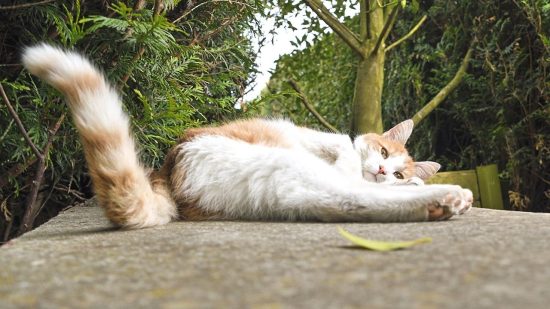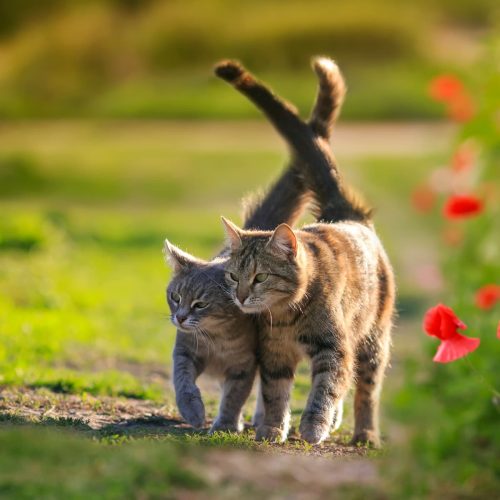What Does it Mean When a Cat Wags its Tail? Is it a sign of it showing love or something else? Let’s find out the truth!
From expressing deep contentment while lounging under your hydrangeas to signaling alertness as they navigate through your carefully tended beds, understanding What Does it Mean When a Cat Wags its Tail can deepen your connection with your furry companion!
What Does It Mean When a Bird Poops on You?
The Basics of Cat Tail Language
Cats talk to us in their own special way; their tails are like their secret code. If we pay attention, a cat’s tail can tell us a whole story about how it’s feeling. It’s like understanding a language that helps us connect better with our furry pals. Let’s look at what a cat’s tail is trying to say.
1. Upright and Quivering
A straight-up tail with a slight quiver at the tip indicates a happy and confident cat. This is often seen when a cat greets its owner or is in a positive, playful mood.
2. Puffed Up
When a cat’s tail puffs up, it’s a sign of fear, aggression, or extreme agitation. This defensive posture makes the cat appear larger to potential threats.
3. Low and Tucked
A low or tucked tail is a clear sign of fear or submission. Cats may exhibit this behavior when feeling threatened or in an unfamiliar or stressful situation.
What Does it Mean When a Cat Rubs Against You?
What Does it Mean When a Cat Wags Its Tail?

1. Slow, Gentle Wagging
A slow, gentle wagging of the tail can indicate that the cat is in a relaxed state. It may be a sign of contentment, especially if accompanied by a purr. This is often seen when a cat is enjoying being petted or lounging in a comfortable spot.
2. Fast, Agitated Wagging
On the other hand, fast and agitated tail wagging usually suggests that the cat is upset, annoyed, or agitated. This can happen when a cat is confronted with a situation it finds threatening or when it’s feeling irritated.
3. Tail Puffing with Wagging
If a cat’s tail is puffed up while wagging, it’s a clear sign of extreme agitation or aggression. This behavior may be accompanied by other signs of distress, such as hissing or growling. It’s crucial to approach a cat exhibiting this behavior with caution.
4. Focused Wagging
Sometimes, a cat may wag its tail with a focused intensity, particularly when watching prey or another animal. This type of tail movement indicates heightened concentration and is often seen during play or hunting activities.
What Does it Mean When You See an Owl?
5. Tail Curled Around Another Cat or Object
If a cat wraps its tail around another cat, an object, or even your leg, it is a sign of affection and camaraderie. This behavior is a display of trust and is often seen in cats that have strong bonds with each other or with their human companions.
6. Tail Held to One Side
When a cat holds its tail to one side while wagging, it may be expressing curiosity or interest. This tail position often accompanies a cat’s exploration of a new environment, indicating a heightened sense of awareness.
7. Flicking or Lashing Tail
A tail that flicks or lashes rapidly from side to side can be a warning sign. This behavior is typically associated with irritation or impatience. It’s essential to proceed with caution in such situations to avoid triggering defensive reactions from the cat.
8. Tail Posing Straight Up
When a cat holds its tail straight up, it signals confidence and a sense of ownership. This is commonly observed when a cat is marking its territory, and the raised tail exposes the scent glands on the underside, allowing the cat to leave its scent on surfaces.
Are Snake Plants Toxic to Cats | Find Out!
9. Tail Between Legs
Similar to dogs, a cat tucking its tail between its legs signifies fear, submission, or anxiety. This behavior is often observed when a cat encounters a dominant or unfamiliar presence and it’s seeking to protect itself.
10. Tail Vibrating or Trembling
If a cat’s tail vibrates or trembles while wagging, it may indicate a mix of emotions, including excitement and anticipation. This can happen during playtime or when a cat is about to pounce on a toy or prey.
What Does it Mean When a Cat Wags its Tail – FAQs

Q1. Should I approach a cat with a wagging tail?
A: Approaching a cat with a wagging tail requires caution, especially if the wagging is fast or accompanied by other signs of distress, such as hissing or growling. Give the cat some space and observe its behavior from a distance. It’s essential to let the cat decide when it’s comfortable with interaction.
Q2. How do kittens use tail language compared to adult cats?
A: Kittens often display exaggerated tail movements when playing or interacting with their littermates. As cats mature, they refine their tail language but still use it to communicate. Adult cats may have more subtle and nuanced facial expressions, but the basic meanings, such as happiness, fear, or aggression, remain consistent throughout their lives.



